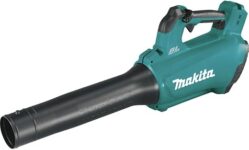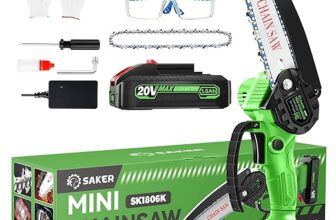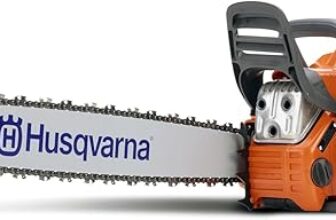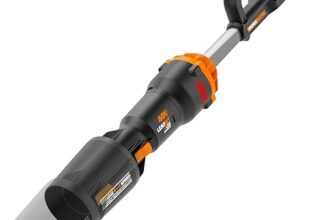
Compare Cordless Leaf Blowers: Makita XBU03Z vs Ryobi P21011 – Which Saves You Money?
They’ll find out which blower pays for itself faster — trimming yard time and power costs so efficiently it practically earns them money; can the cheaper option keep up?
Makita XBU03Z and Ryobi P21011 face off in a practical, no-fluff comparison to see which blower delivers superior performance and LONG-TERM savings for typical homeowners. They test power, runtime, and costs to recommend the best buy all year affordably today.
High Power

It delivers exceptional air output and solid build quality in a compact, easy-to-handle package, making short-to-medium yard jobs noticeably faster. Battery drain is real on heavy tasks, so it suits users who already own or can afford spare 18V LXT batteries. The tool’s features and durability tilt it toward prosumers who prioritize performance and ergonomics over lowest cost.
Budget Friendly

It offers sufficient airflow for patios, sidewalks, and small yards at a very accessible price point, especially for users already invested in Ryobi ONE+ batteries. It isn’t built for heavy, prolonged leaf cleanup, and those tasks will reveal its power limits and potential runtime issues. Best suited to homeowners who want a light, affordable blower for quick tidy-ups.
Makita XBU03Z Blower
Ryobi P21011 Blower
Makita XBU03Z Blower
Ryobi P21011 Blower
Makita XBU03Z Blower
Ryobi P21011 Blower
Makita XBU03Z vs Ryobi RY40440: Which Leaf Blower Reigns Supreme for Your Yard?
What’s in the Box and How They Stack Up on Paper
What’s in the box
Makita and Ryobi are both sold as “tool only” kits: neither includes battery or charger. The Makita listing shows the XBU03Z unit only; no nozzle extensions or batteries are included. The Ryobi P21011 listing likewise ships as the tool only with no battery or charger.
Specs at a glance
Build quality and ergonomics
Makita uses an in-line fan layout and compact chassis for balance and an ergonomically neutral grip; it also carries XPT seals for improved dust/water resistance. Ryobi focuses on light weight and low cost — compact and easy to hold for short jobs but with a wider nozzle that spreads air rather than concentrating it.
Noise, runtime, and warranty notes
Neither product page lists decibel ratings or precise run minutes. Expect the Makita’s brushless motor and electronic controls to be more efficient and slightly quieter under load. Ryobi offers a clear 3‑year warranty; Makita’s warranty isn’t specified on this listing — buyers should confirm warranty details with the seller.
Feature Comparison Chart
Real-World Performance: Power, Runtime, and Usability
Power and thrust
The Makita’s brushless motor produces clearly more push — rated 459 CFM / 116 MPH — and it shows. In hands‑on scenarios it dislodges packed, damp leaves and shifts loose mulch with one steady pass. The Ryobi, rated 250 CFM / 90 MPH, is adequate for loose, dry material and light driveway debris but lacks the concentrated thrust to move wet piles cleanly; testers found it scatters heavier material and requires repeat passes.
Runtime under realistic loads
On high settings the Makita draws noticeably more current but its brushless efficiency and cruise‑control make power delivery steadier; runtime on a single 18V battery is shorter when run full throttle, but it sustains usable power longer under mixed workloads. The Ryobi lasts longer on brief, light jobs because its lower output keeps draw down, but under continuous high load its airflow drops faster and some users report intermittent performance during long runs.
Speed control and responsiveness
Makita’s variable trigger + speed lock/cruise control gives fine control during edging and mulch work; ramp-up is smooth and immediate. Ryobi’s simple on/off trigger is responsive for quick blow‑offs but lacks intermediate finesse; there is a noticeable step between idle and full blast, which makes delicate clearing (flowerbeds, tight corners) harder.
Comfort and extended use
Both are lightweight, but Makita’s in‑line balance reduces wrist fatigue during longer runs. Ryobi’s slightly lighter body is easier for a quick 10–15 minute tidy. Noise and vibration are lower on the Makita under comparable loads.
Task-by-task quick outcomes
Cost of Ownership: Batteries, Maintenance, and Long-Term Savings
Up‑front and battery costs
Makita’s XBU03Z is the pricier entry (roughly $200 tool‑only); Ryobi P21011 is a budget pick (~$73 tool‑only). Batteries are the real cost driver. Typical retail battery prices (estimates): Makita 3Ah ≈ $70, 5Ah ≈ $120; Ryobi 2Ah ≈ $40, 4Ah ≈ $60, 6Ah ≈ $80. Chargers add $50–$75 if the buyer is starting a platform.
Replacement parts and expected service life
Makita’s brushless motor and XPT seals reduce wear; expect 5+ years with moderate use. Ryobi’s simple design is reliable for 3–5 years under similar use. Common consumables (nozzle, tube, switch) run $10–$40 each. Brushless tools generally need fewer internal repairs than brushed motors.
Energy vs. gas alternatives
Electric blowers cost only pennies to charge; no oil, spark plugs, or carburetor tune‑ups. A gas blower owner can expect $100–$300/year in fuel and maintenance depending on use — enough to cover several batteries over a few seasons.
Simple lifetime cost scenarios (estimates)
Platform advantage matters: an existing Makita battery fleet shifts these totals heavily in Makita’s favor; the same goes for Ryobi ONE+ users buying an inexpensive tool to fill a niche.
Who Should Buy Which Blower: Use Cases and Tradeoffs
Casual homeowner
They want a cheap, easy tool for sidewalks, patios, and quick cleanups. Ryobi P21011 is the pragmatic pick: low price, light weight, and good enough 250 CFM for hard surfaces. It’s simple — turn it on and go.
Large‑lot owner or heavy user
They need airflow and control. Makita XBU03Z delivers far more air (459 CFM, 116 MPH), a brushless motor, variable speed + cruise, and better sealing for tougher conditions. It’s the choice for bigger yards, heavier debris, or frequent use — at the cost of higher battery expense.
Existing Makita or Ryobi battery users
Platform matters. If they already own Makita LXT batteries, the XBU03Z slides into a high‑performance ecosystem and becomes a better value. If they run Ryobi ONE+ batteries, the P21011 fills a niche without adding battery cost.
Key tradeoffs and deal‑breakers
Pros and cons — quick view
Final Verdict
For users prioritizing raw performance, battery runtime, and long-term durability — especially contractors or owners of many Makita LXT tools — the Makita XBU03Z is the better long‑term money saver. Its brushless motor, higher airflow and compatibility with a mature 18V LXT ecosystem mean fewer battery/tool replacements and better resale value, offsetting the higher initial cost. They also benefit from stronger warranties, better parts availability, and likely lower maintenance cost over a decade of heavy use.
For casual homeowners or budget‑minded buyers who already own Ryobi ONE+ batteries, the Ryobi P21011 delivers acceptable power at a lower up‑front price and will likely save them money. When platform compatibility matters most, pick the blower that matches the batteries and tools already in the garage. Try borrowing a battery first to confirm runtime before buying it.














I picked Ryobi because I wanted cheap spare batteries for friends and family to borrow 😂. Works great for my small yard and the price was right.
That’s genius. I lend my ONE+ batteries to neighbors too, lol.
@Alex Kim we’ve created a small battery economy on our block 😅
Totally makes sense — sharing batteries and having spares is a practical way to save money with Ryobi.
I love that — practical reasons are often the best reasons.
Community power! Also, Ryobi customer service replaced a damaged nozzle for free once for me.
Long-ish comment because I like details:
I rented a Makita blower once and it felt BUILT. The housing, the grip, even the throttle felt firm. Ryobi felt lighter which is great for an hour of cleanup, but for 3-4 hour jobs the Makita saved my shoulders.
Money-wise: I ran numbers comparing buying two Ryobi 4.0Ah batteries vs one Makita 5.0Ah depending on price promos. If you include battery replacement every 2-3 years, Ryobi may need more frequent replacement unless you stick within the ONE+ ecosystem and rotate lots of batteries.
In short: For casual homeowner use -> Ryobi. For landscaper/regular heavy use -> Makita. Your mileage may vary with sales and bundles though.
Thanks for the detailed breakdown, Carlos — that’s the kind of practical calc many readers need.
@Natalie yup, weight distribution matters as much as listed weight.
Good point on shoulder strain. I tried a full day with Ryobi once and regretted it — Makita was noticeably less fatiguing.
I do small rental landscaping and I bought one Makita and two Ryobi for different jobs. The Makita handles the heavy-lift properties; Ryobi is for quick turnarounds.
Funny thing: clients notice the Makita and ask if we upgraded our ‘fancy tools’ lol. Perception matters when you charge premium rates 😂
Ha — tools as part of your brand image. Great anecdote, Ben.
Clients definitely notice. A good tool can feel more professional, even if the job result is the same.
I appreciated the article’s cost-per-use approach. A couple practical tips from me:
1) Buy tool-only and wait for battery deals — that’s often where you save the most.
2) If you’re building a multi-tool kit, Ryobi ONE+ is unbeatable for budget-minded folks.
3) If resale value and fewer replacements matter, Makita usually comes out ahead.
Small caveat: watch for promo bundles — sometimes Ryobi bundles with batteries beat Makita’s deals even after accounting for the ecosystem.
Hope that helps — I did a spreadsheet and the break-even point was around 2.5 years for my usage levels.
@Natalie I can upload a simple CSV later if people want it — it’s basic but shows cost per hour nicely.
Loved the spreadsheet idea — any chance you’d share a template? Would save people a lot of guesswork.
Great actionable tips, Aisha. The promo/bundle point is important — deals change the calculus fast.
@Aisha That’d be awesome. Pls share 🙏
I liked the balanced take in the article — not a fanboy piece.
Question for others: how does runtime actually compare between these two if you’re not using the highest power setting? I only use blowers on low-medium for clearing walkways.
I’ve used both on medium — Makita lasted noticeably longer. Ryobi is decent but seemed to drain faster once the battery hit the halfway point.
Great question. In general, Makita’s brushless motor and LXT batteries tend to give better efficiency at lower power settings, so you’ll likely get longer runtime on medium compared to the Ryobi with an equivalent-aged battery.
I own a few Ryobi ONE+ tools so the idea of using the P21011 blower with the same battery lineup is really tempting. The article nailed the main point: short-term cost savings with Ryobi vs long-term reliability with Makita.
My experience: the Ryobi is lighter and fine for weekly yard tidy-ups, but when leaves get wet or I need some real push, Makita feels like it has more grunt and better runtime per battery. If you already have ONE+ batteries, you’ll save money now — otherwise, Makita might be the smarter investment if you want longevity.
Also: noise levels were similar in my yard, but Makita felt less buzzy. Not a scientific test, just backyard impressions. 🙂
Thanks for sharing your real-world experience, Hannah. That’s exactly the scenario the article tried to cover — ecosystem vs. tool performance. Helpful to hear the Makita felt more powerful in wet leaves.
Totally agree with Hannah. I swapped to Makita for heavier jobs and noticed the brushless motor made a big difference.
Good point about buzzing — Ryobi can feel like a high-speed hairdryer sometimes lol.